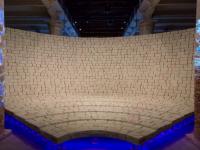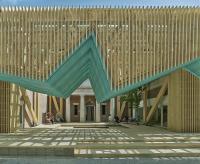Sports and Concert Complex
St. Petersburg, Russia
Coop Himmelb(l)au’s design follows the tradition of Russian constructivism
At the time of Constructivism, Russia produced unique milestones in architectural history. Artists such as Tatlin and El Lissitzky inspired architects worldwide and redefined the level of artistic aspiration in architecture. The design of the new CKA Ice Hockey Arena in St. Petersburg follows the tradition of this unique era of constructivism, where everything was possible, and translates its expressive, open design language into a contemporary context: the filigree framework of its construction, based on Tatlin's “Monument to the Third International,” is transferred to the flowing, dynamic movement of a person skating around the stadium.
Structural Ring
A structural ring serves as additional support for the roof structure. The ring geometry is differentiated in four segments, which work within the global structural system, and four segments that support only themselves, as well as allow for big entrance openings. The wall-like steel structures support the roof in four different areas around the stadium building. They are shaped as straight surfaces, or reinforce the folded surface geometry with a second layer of structural elements. Members are designed as rectangular hollow cross sections optimized for buckling resistance. Cross-section dimensions are optimized, and vary in gradients to the amount of vertical load transfer. The steel structures of the ring also provide horizontal bracing in it’s surface direction. They furthermore rest on the plinth building base, which is mainly designed as a reinforced concrete structure.
Stadium Building
The existing stadium design consists mainly out of elements in reinforced concrete. Columns and walls transfer the main vertical loads towards the ground. Concrete cores as well as wall elements brace the building in horizontal direction and transfers the main horizontal loads towards the ground. Plinth The base plinth structure is designed in reinforced concrete columns, walls and a beam construction with a lightweight concrete slab.
Roof Structure
A spatial steel truss system based on a bi-axial layout composes the light-weight roof structure. The structure of the roof is developed hand-in-hand with the pre-existing stadium design. The beam layout respects and adapts to the preexisting structural axis around the stadium bowl. It uses predefined support points. Truss directions are aligned with the main cantilevering directions, which creates a more efficient force flow towards the most cantilevering parts of the roof. The spatial truss structure is further subdivided in mega-trusses and secondary beams, which allow for a shortened span distance for the roof-skin construction. Top and bottom girder are designed as simple shaped cross sections, which allows for simple standard details for all joints. Diagonal members are designed as rectangular hollow cross sections optimized for buckling resistance. The height of the spatial truss structure is adjusted to the force flow – close to supports and at areas in the middle of bigger spans the structural height is bigger – the edges of the structure are kept slender.
Foundation
The foundation of the building is designed as a raft foundation with a minimum thickness of 1m with local thickening in areas below the columns. In areas of large concentration of high loads (such as the structural ring segments) the thickness of the raft foundation increases. Bored Piles transfer the loads from the foundation plate to the loadbearing ground.
A vibrant heart at the center of the newly created park
Without changing the existing planning inside the arena, a second, transparent cladding is created, which serves as a supporting structure for the overlying, dynamically cantilevered roof. This filigree construction is only interrupted by arches at those points where the stairs to the ring-shaped plinth are placed. This creates a covered arcade that is protected from wind and rain that can also be used for merchandising shops and food stands. Balconies, which are attached to the thermal shell within these arcades, connect the functional areas inside the arena with the protected outside space and can also be used as lounges and restaurant terraces outside of event times. A transparent media screen made of LED dots inside the glass envelope communicates the current events over a large area in the area around the arena.
The roof of the arena is shaped like a flattened dome. This is equipped with solar panels on the side facing the sun and equipped with an LED screen above the main entrance, which can be seen from afar.
These measures transform the building into the vibrant heart at the center of the newly created park complex for the people of St. Petersburg, usable around the clock.
A park for year-round use
The park, with its event and sports areas, is designed for year-round use. It is criss-crossed by two categories of path networks: The first category is straight axes that connect important points in the park and enable quick traversal of the facilities. The vectors of these access routes are derived from a work by El Lissitzky and are symbolic of power and energy. The second category consists of paths that wind through the park and invite you to stroll. Various zones for sports and leisure activities are embedded in these path networks.
The respective zones, with their different functional areas, flow smoothly into one another and are still spatially perceptible for the visitor. At the edge of the zones, spectator stands are integrated into the landscape and protect the respective sports fields from the wind.
Service pavilions for gastronomy are arranged between the various facilities, as well as relaxation areas with shady tree plantings that invite you to linger. Staggered rows of trees are arranged as wind protection towards the street.
Along the arena’s main entrance axis are two ticket boxes upon which sculptures are mounted on the roof, the shape of which being derived from the figure skating figures of Nikolai Alexandrovich Panin-Kolomenkin. The paving is provided in two-tone concrete blocks, which create a flowing pattern that emphasizes the unmistakably exciting nature of this public space.
Things to know
Vladimir Tatlin (1885-1953) was a Russian artist and architect. Tatlin’s Tower, or the project for the Monument to the Third International (1919–20), was a design for a grand monumental building that was never built. It was planned to be erected in Petrograd (now St. Petersburg). The tower’s main form was a twin helix which spiraled up to 400 m in height, around which visitors would be transported with the aid of various mechanical devices.
El Lissitzky (Lazar Markovich Lissitzky, 1890-1941) was a Russian artist, designer, photographer, typographer, polemicist and architect. He was an important figure of the Russian avant-garde.
Nikolai Aleksandrovich Panin-Kolomenkin (1872-1956) was a Russian figure skater and coach. He won the gold medal in special figures in the 1908 Summer Olympics, became one of the oldest figure skating Olympic champions. Panin was Russia’s first Olympic champion.


- Architects
- Coop Himmelb(l)au
- Localització
- St. Petersburg, Russia
- Any
- 2020-2023
- Architect
- Coop Himmelb(l)au Wolf D. Prix & Partner ZT GmbH
- Design Principal
- Wolf D. Prix
- Managing Partner
- Markus Prossnigg
- Design Partner
- Alexander Ott
- Project Partner
- Benjamin Schmidt
- Project Team
- Poltak Pandjaitan, Tyler Bornstein, Balbina Scheitnagl, Shir Katz, Eren Adanl
- 3D Visualization
- Constantin Papachristopoulos, Christos Grapas, Iraklis Alexandros Kallioras, Tudor Sabau
- Graphic
- Jan Rancke
- Structural Engineering
- B+G Ingenieure Bollinger und Grohmann Gmbh | Austria, Vienna Prof. Klaus Bollinger, Moritz Heimrath, Adam Orlinski
- Facade Engineering
- B+G Ingenieure Bollinger and Grohmann S.a.r.l. | France, Paris Niccolo Baldassini, Nicolas Polaert
- Lighting Design
- a·g Licht GbR Planungsbüro | Germany, Colone Wilfried Kramb
- Landscape Planning
- Rajek Barosch Landschaftsarchitektur | Austria, Vienna Oliver Barosch
- Traffic Planning
- Rosinak & Partner ZT GmbH | Austria, Vienna Philip Rosinak
- Competition SCA Arena and Park Competition
- 2021/2021, Winner













